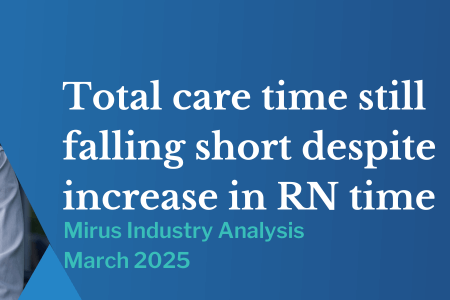The 3 questions everyone asks about AN-ACC
April 10, 2024 | AN-ACC

By Aron Wong, Senior Consultant
Through our Mirus Academy training programs, we speak with hundreds of people working in the aged care sector in Australia, including many looking to enter aged care from other industries.
Here are the three of the most commonly asked questions and themes that have been raised in our Mirus Academy Courses, particularly in the first three months of 2024.
1. When will the new AN-ACC pricing be announced?
New AN-ACC prices will be announced in August 2024.
Many of us have been accustomed to the 1st of July fiscal year updates regarding pricing for the old ACFI rates. However, this has now changed. According to the Department’s website on Funding and the Fair Work Commission Annual Wage Review in residential aged care , new AN-ACC prices will be announced in August 2024 and will come into effect on the 1st of October every year. The Department has shifted the AN-ACC price adjustment from July to October to allow the Independent Health and Aged Care Pricing Authority (IHACPA) to incorporate the outcome of the Fair Work Commission’s Annual Wage Review (FWC AWR). This change aims to provide providers with more confidence that AN-ACC funding will cover their wage costs. One of the challenges this change may pose for organisations with an annual budgeting process is the need to factor in any pricing changes announced in August. Budgets are often finalised in the lead-up to 1st July for the following fiscal year. Conversations are already underway about the processes that aged care organisations may need to change or adjust internally to incorporate any pricing adjustments into their budgets.
2. Which care minutes are counted and which are not?
RNs, ENs, and PCWs/AINs’ worked time performing direct care activities excluding certain other activities as noted in the Care Minutes guide section 3, and being paid at the right award can potentially be counted.
I would like to take you through a few key points below when considering how to figure out the correct direct care minute calculations for your organisation. However, it is important to note that this is not an all-inclusive ‘how-to’ guide. If you would like further assistance, you can reach out to us for help, and we can assist you with Care Minute Policy Assurance to prepare you for the Care Time Reporting Assessments being completed.
When considering how to calculate your care minutes delivered, the best place to start is directly in the Care Minutes and 24/7 Registered Nurse Responsibility Guide. It is important to remember to check the guide frequently, as there may have been updates since your last reference to the document. You will notice the Department has a ‘Guide Updates’ section near the top, which highlights the date of the update and what has been updated.
Some basic things to consider when looking at direct care minute calculations and what to include are the following points:
- Care minutes can only be counted if delivered by certain staff. The Department notes that ‘Care minutes can only be delivered by one of the following specified care workers,’ which includes registered nurses (RNs), enrolled nurses (ENs), and personal care workers and assistants in nursing (PCWs/AINs). These roles are defined in the guide.
- Enrolled nurses count toward the total care minute target but NOT the registered nurse target.
- PCWs and AINs must be paid at a certain Aged Care Award or mapped to that award if a separate agreement is in place. For PCWs and AINs, it is especially important to look at the Department’s definition in the guidelines, as some individuals may be unaware of this definition even in recent months.
When considering care minutes related to PCWs and AINs, it is also crucial to note the Award or Agreement under which the staff member is paid to determine whether to count their time. The Department’s guidance, found in Section 2.3 of the guide, outlines this: “A PCW is an employee classified under Schedule B.2 in the Aged Care Award 2010 as an Aged Care employee – direct care Level 2 (Grade 1 PCW) to Aged Care employee – direct care Level 7 (Grade 5 PCW) (excluding Aged Care employee- direct care Level 6), or in an equivalent role in an equivalent award or enterprise agreement or individual contract/agreement. An AIN (or Nursing Assistant) is an employee classified under Schedule B.2.1 in the Nurses Award 2020.
- Check Section 3.1 in the guide for the direct care activities that may be included in direct care minutes.
- Check Section 3.3 to understand what activities are NOT counted as direct care activities.
- Refer to Appendix 2 for various scenarios and examples, especially those involving ‘Hybrid Roles.’
All this being said, particularly when it comes to AINs and PCWs, the staff member must be paid at the right Award AND be completing the direct care tasks that are countable. If both criteria are not met, then the minutes may not be deemed countable.
3. What do I need to be thinking about for October 2024’s increase in mandatory care minutes to 215 care minutes and 44 RN minutes?
One of the most common discussion topics in training is the difficulty aged care providers are having getting enough staff, keeping staff, and the quality of staff available. While this has been a longstanding challenge for aged care, this is of particular interest to the industry as it moves towards meeting the Mandatory Care Minute requirements in October 2023. There have even been some closures to facilities because of the lack of staff availability, or in other cases mergers with other organisations. The main question we see is how you can continue to meet requirements with a shortage of staff? There seems to be both many answers and no answers to this question and it continues to be one of the most enduring challenges in the industry.
Aged care homes need to perform the analysis to understand the impact of these care minute increases and whether the current rosters and staffing capacity will be adequate to meet these increases, or whether changes need to be made to the AN-ACC case mix to be compliant.The Department has published a handy table in the care minutes guide in Section 4.4.2 for the Care Minute Target Calculation periods for the upcoming quarters. You can find a copy below, with an added extrapolation into the October 2024 Quarter based on the assumption of a similar schedule.

If we note that the calculation period for the Mandatory Care Minute Target increase in October is likely to be June to August 2024, then we have less than three months to prepare for that quarter before the data starts to factor into our October period.
Aside from the usual regulatory, legislative, and clinical considerations that we must always adhere to in our planning, it will be important to consider the following:
When the care minutes increase in October, do I have enough staff hours available to be compliant with the new targets based on the increase?
If not, then one might consider possibly adjusting the overall consumer case mix of the facility in the lead up to June 2024’s calculation period so that the October 2024 care minute target is one that can be achieved based on the ‘live’ calculation period of June to August’s AN-ACC Case Mix of the consumers in the facility. Alternatively, do we need to consider recruiting additional staff to meet any changes that may be required?
If the staffing levels are enough to meet the required care minute increases, do we have a buffer to accommodate any potential future increases in care minute targets, or are we nearly maxed out in staff capacity.
Another question to consider is how you will account for potential staff cost increases in the upcoming budgeting period later in the year. It is best to start running scenario analyses now in preparation for that time.
If you need help or more information on preparing for the October 2024 increase in care minutes, please feel free to reach out to us.


